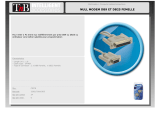
- 3 -
2.3. Verify the driver status
Use the Moxa diagnostic utility to verify the driver status:
#cd /moxa/mxser/utility/diag
#./msdiag
2.4. Test the tty port
Use the Moxa terminal utility to test the tty ports:
#cd /moxa/mxser/utility/term
#./msterm
3. Intelligent RS-485 (If your multiport serial board is
CP-102E/CP-102EL, CP-132EL/CP-132EL-I, or
CP-114EL/CP-114EL-I, then your software installation is completed.
On the other hand, if your multiport serial board is PCI Express-A,
and with interface RS-485-2W, then you should follow this section to
complete the intelligent RS-485 setting.)
• For Windows OS
3.1. Go to the device management to complete the model
properties setting.
3.2. Click Start Diagnosis. (It should be RS-485-2W).
If the status is OK, nothing further needs to be done.
If the status is Waveform Distortion, Data Error, or
Receive Reflect Signal, go to next step to do the auto
tuning
3.3. Auto Tuning
Still in the Properties Settings page, click on the COM
number that shows the error message.
Click Auto Tuning.
Click OK to apply the setting adjustment for the Bias
Resistor and Termination Resistor.
• For Linux
Follow these steps to configure the Intelligent RS-485 in Linux
3.1. Detect the configurations of the port by the following
command:
#./muestty -g /dev/ttyMUE1#cd /
3.2.Use the following command to run diagnosis to see if the
setting is correct.
#./muestty -d /dev/ttyMUE1
3.3. If the alarm status shows OK, nothing further needs to
be done. If the alarm status shows Fail, then there are
problems with the setting. Do the auto-tuning process with
the following command
#./muestty -a /dev/ttyMUE1
3.4. Manually configure the Pull Up/Down resistor and the
terminator resistor with the assigned values:
#./muestty –p (assigned value) /dev/ttyMUE1
#./muestty –t (assigned value) /dev/ttyMUE1
3.5. Do the diagnosis again:
#./muestty -d /dev/ttyMUE1














